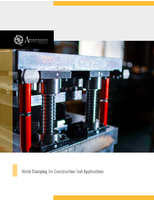Product Development Software leverages HD3D environment.
Press Release Summary:
Via HD3D visual environment, NX(TM) v7.0 helps global product development teams access PLM information to enhance ability to make efficient and effective product decisions. Included synchronous technology - CAD/CAM/CAE analysis productivity software - further accelerates product development tasks and expands ability to work with data from third-party CAD applications. Geometry creation and editing tools as well as synchronous pattern capability are standard.
Original Press Release:
Siemens PLM Software Delivers NX 7.0 with "HD3D" and Enhancements to Synchronous Technology
Innovative New Open Solution for Fast and Accurate Visual Analytics Expands NX Leadership Established with "Groundbreaking" Synchronous Technology
PARIS and PLANO, Texas, October 7, 2009 - Siemens PLM Software, a business unit of the Siemens Industry Automation Division and a leading global provider of product lifecycle management (PLM) software and services, today announced the latest release of NX(TM) software, the company's flagship digital product development solution. With NX 7.0, Siemens PLM Software introduces HD3D, an open and intuitive visual environment to help global product development teams unlock the value of PLM information and significantly enhance their ability to make efficient and effective product decisions. In addition, NX 7.0 includes enhancements to synchronous technology - the widely acclaimed computer-aided design, manufacturing and engineering analysis (CAD/CAM/CAE) productivity software introduced by Siemens PLM Software last year - that will further accelerate a variety of product development tasks and expand the unmatched ability of NX to effectively work with data from third party CAD applications.
The announcement of NX 7.0 was made today in Paris at the Siemens PLM Connection Europe annual users conference.
"Our introduction of synchronous technology and its implementation into NX earned high praise, not only from the vast majority of CAD/CAM/CAE pundits and industry analysts, but more importantly from the companies that deployed it to boost their design productivity," said Joan Hirsch, vice president of Product Design Solutions, Siemens PLM Software. "Today's launch of NX 7.0 builds on that productivity leadership with the addition of significant new synchronous technology functionality, and the exciting introduction of HD3D, an innovative environment that will accept data from a variety of sources to set a new standard for 'High-Definition' visual analytics in product development."
The need for visual information
Globalization and an escalating regulatory environment, coupled with the increasing sophistication of virtually all manufactured products, has created a complex product development process for companies worldwide. Hundreds of decisions need to be made throughout product development based on information that exists in a variety of formats and locations, and usually created by software applications from multiple vendors. The speed and accuracy with which those decisions can be made has a profound effect on a company's success.
"A natural and effective way to address these obstacles is to use visual information as a way to communicate across barriers and level the playing field for all participants," said Joe Barkai, Practice Director of Product Lifecycle Strategies for IDC Manufacturing Insights. "A collaborative decision-making process and visually-assisted tools that support it are essential for expeditious, informed and reliable decisions. Using these tools will facilitate better communication and understanding, and increase the fidelity of informed decisions across the enterprise."
A new visual analytics paradigm
The introduction of HD3D in NX 7.0 is part of Siemens PLM Software's comprehensive approach to achieving this vision and establishing a new paradigm in visual analytics. HD3D is a visually-rich environment for working with virtually any type of PLM data. This environment will be common across NX and Teamcenter® software, Siemens PLM Software's industry-leading digital lifecycle management portfolio, and its open architecture will also allow for integration with a variety of third-party applications.
HD3D expands the power of NX and Teamcenter to visually deliver the information companies need to understand, collaborate, and make decisions in today's globally distributed and heterogeneous product development environments. HD3D provides a simple and intuitive way to collect, collate and present product information, where it can be immediately applied in critical decision-making. The implementation of HD3D in NX 7.0 will enable users to visually interrogate and evaluate a product design based on any type of data tracked in Teamcenter or NX, such as release status, weight thresholds, material type, delivery status, etc.
For example, an NX 7.0 user could run a report looking for parts that are currently in development and registered as on-schedule or late. The 3D NX model of the product will visually highlight all of the parts that are more than one week late and a cause for concern. Interactive tags are displayed on the screen and can be selected to navigate into more detailed information. With potentially thousands of parts in a given product, this visual feedback and interactive work environment eliminates the need to sort through written bills-of-materials and status reports to manually interpret where issues exist and what action to take.
In addition to this visual analytics capability based on PLM data, HD3D will be implemented within NX 7.0 Check-Mate, a standards-based checking application that ensures compliance with design criteria, consistency in CAD model file structure and adherence to a variety of corporate and industry standards. HD3D will enhance validation tools within Check-Mate with a new visual user interface for analyzing and reporting issues. Similar to the above example, the new environment improves decision making during product validation by providing an intuitive, visual means of viewing Check-Mate results and evaluating issues.
Expanding synchronous technology leadership
Dr. Ken Versprille, PLM Research Director for industry analyst firm CPDA, refers to synchronous technology as, "one of the most important, groundbreaking technical advancements in 3D solid modeling in over twenty years." NX 7.0 builds on its strong leadership position in modeling flexibility and productivity with further enhancements to synchronous technology aimed at greater efficiency, enhanced reuse of legacy data and expanded interoperability with multiple third party CAD systems.
Faster geometry creation and editing tools further accelerate a variety of tasks associated with creating and modifying designs. Design intent is applied and preserved at the time of change and reliable editing eliminates update failures and long replay times.
Powerful new synchronous pattern capability removes the need to understand the original creation approach when working with legacy CAD models and expanded capabilities for cut, copy, paste and mirror further improve productivity. This makes it easier to adapt new designs from older models and saves significant time and expense through improved reuse of design data.
New "clean-up" tools enable faster and easier editing of models imported from third-party CAD systems. Automatic and semi-automatic blend and chamfer recognition builds and maintains relationships for two of the most common manufacturing features, while automatic and manual healing options along with the ability to merge segmented geometry removes unwanted gaps and fixes mismatched geometry.
The synchronous technology enhancements in NX 7.0 impact all aspects of CAD/CAM/CAE. In addition to its obvious affect on productivity for product designers, the new functionality significantly benefits other members of the development team working with CAD data, including analysts and manufacturing engineers. These individuals primarily work with 3D models created by someone else and often times using a third-party CAD application.
Synchronous technology opens up a range of new opportunities for CAE and CAM users to directly leverage CAD geometry from any source. The easy to use interface in NX 7.0 enables these users to easily modify 3D models for their specific requirements, enabling them to add value by focusing on their respective areas of expertise. The combination of NX and synchronous technology establishes a new modeling paradigm throughout the product lifecycle.
"We replaced our previous 3D CAD system with NX because of its superior ability to enable easy and flexible manipulation of non-parametric geometry," said Markus Pichler, Product Development Manager, BWT AG. "We believe the enhanced synchronous technology capabilities in NX 7.0, with its new geometry healing options, will further extend our ability to rapidly edit legacy and third-party CAD data, creating enormous time savings and further streamlining our supply chain."
About Siemens PLM Software
Siemens PLM Software, a business unit of the Siemens Industry Automation Division, is a leading global provider of product lifecycle management (PLM) software and services with nearly six million licensed seats and 56,000 customers worldwide. Headquartered in Plano, Texas, Siemens PLM Software works collaboratively with companies to deliver open solutions that help them turn more ideas into successful products. For more information on Siemens PLM Software products and services, visit http://www.siemens.com/plm.
About Siemens Industry Automation Division
The Siemens Industry Automation Division (Nuremberg, Germany) is a worldwide leader in the fields of automation systems, low-voltage switchgear and industrial software. Its portfolio ranges from standard products for the manufacturing and process industries to solutions for whole industrial sectors that encompass the automation of entire automobile production facilities and chemical plants. As a leading software supplier, Industry Automation optimizes the entire value added chain of manufacturers - from product design and development to production, sales and a wide range of maintenance services. With around 42,900 employees worldwide Siemens Industry Automation achieved in fiscal year 2008 total sales of EUR8.7 billion.




